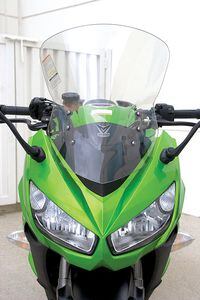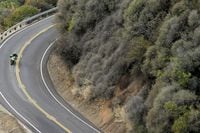- WRIST: Kevin Smith
- MSRP (2014): $11,999
- MILES: 7,388
- MPG: 39
- MODS: National Cycle & MRA windshields
This is Windshield Month. Time to see if I can improve the Ninja 1000’s cockpit airflow. I’m not looking for protection from wind, exactly, just better management of it. I hate being a spinnaker, catching the wind with my chest. I also dislike helmet buffeting, which rattles my brain and fatigues my ears.
My personal ideal, then, is airflow that just clears my shoulders while staying clean where my helmet cuts through it. Doing crude aero research on the freeway with my left hand, I could feel around the Ninja cockpit and identify the still-air space down inside, the free air stream up above, and the transition zone where the air tumbles in between.
The Ninja’s small standard windshield does a decent job. In my preferred middle position (of three), it provides sufficiently clean and quiet flow to the helmet. The transition zone between fast air and still air hits me (I’m just about 6 feet) mid-chest, well below my shoulders. Could I move the transition zone higher without the flow becoming dirty around my helmet?
First I mounted an MRA Double Bubble Racing Screen (twistedthrottle.com; $108). It’s almost the same size as stock (a quarter-inch taller, half an inch wider) but shaped very differently: more organic, with deeper curvature in the center.
On the freeway, the MRA screen lifted the aero transition zone almost to the tops of my shoulders, about the bottom of my helmet’s chinbar. Noise and buffeting were not significantly increased. I considered this a useful improvement. Dropping the MRA screen to the lowest position relocated the transition zone to mid-chest, roughly where it was with the stock screen in the middle position.
Next I tried a more touring-oriented alternative. National Cycle’s V-Stream Sport/Tour windshield (nationalcycle.com; $150) is much taller (by more than 2 inches) and wider (3 inches) than stock.
Even before getting to the freeway, I noticed more wind roar behind the V-Stream, but the flow was not turbulent. At cruise, even in the low position, the V-Stream put the transition zone above my shoulders, near the middle of my face shield. I liked the compromise. Since the airflow at the helmet was still smooth, the noise itself was little bother and easily managed with earplugs. Meanwhile, my whole upper body felt cosseted in the still-air space.
My conclusions: 1) The Ninja 1000’s standard airflow management is good but can be improved. 2) MRA’s Double Bubble works and looks better. 3) The V-Stream really moves the wind aside while making a little more noise. 4) Ideally, I’d use the MRA around town and swap to the V-Stream for a longer trip. And with the Ninja’s easy six-screw windshield mounting (it takes three minutes to change), I can.
















/cloudfront-us-east-1.images.arcpublishing.com/octane/S35YGSEMEZB4BLTDJTSZPF4GLA.jpg)
/cloudfront-us-east-1.images.arcpublishing.com/octane/5UOT6HPX2JFMRJAX6EH45AR4MQ.jpg)
/cloudfront-us-east-1.images.arcpublishing.com/octane/OKWOJWAKP5EP3OACCRRWPCIX2Q.jpg)
/cloudfront-us-east-1.images.arcpublishing.com/octane/2WF3SCE3NFBQXLDNJM7KMXA45E.jpg)
/cloudfront-us-east-1.images.arcpublishing.com/octane/G4MG6OUCJNBSHIS2MVVOTPX65E.jpg)
/cloudfront-us-east-1.images.arcpublishing.com/octane/IIGGWFOTOJGB7DB6DGBXCCMTDY.jpg)
/cloudfront-us-east-1.images.arcpublishing.com/octane/QSTCM6AVEZA5JJBUXNIQ3DSOF4.jpg)
/cloudfront-us-east-1.images.arcpublishing.com/octane/U4I7G625B5DMLF2DVIJDFZVV6M.jpg)
/cloudfront-us-east-1.images.arcpublishing.com/octane/B6XD6LS6IVCQPIU6HXDJSM3FHY.jpg)
/cloudfront-us-east-1.images.arcpublishing.com/octane/ICL63FEDDRDTTMINYICCEYGMDA.jpg)
/cloudfront-us-east-1.images.arcpublishing.com/octane/FCGZHQXRBZFLBAPC5SDIQLVF4I.jpg)
/cloudfront-us-east-1.images.arcpublishing.com/octane/WNOB6LDOIFFHJKPSVIWDYUGOPM.jpg)

/cloudfront-us-east-1.images.arcpublishing.com/octane/X33NU3E525ECRHXLNUJN2FTRKI.jpg)
/cloudfront-us-east-1.images.arcpublishing.com/octane/6KKT5NNL2JAVBOXMZYS5ZO76YA.jpg)
/cloudfront-us-east-1.images.arcpublishing.com/octane/J5RKG5O455GMPGQRF2OG6LRT7A.jpg)
/cloudfront-us-east-1.images.arcpublishing.com/octane/GX2CIZKQVRH2TATDM26KFG2DAE.jpg)
/cloudfront-us-east-1.images.arcpublishing.com/octane/ZWIDYSAKQZHD5BHREMQILXJCGM.jpg)
/cloudfront-us-east-1.images.arcpublishing.com/octane/CYUHJZCTSJCH3MRAQEIKXK7SCQ.jpg)
/cloudfront-us-east-1.images.arcpublishing.com/octane/LKOFINY56FCXJCANJ5M7ZDQUBY.jpg)
/cloudfront-us-east-1.images.arcpublishing.com/octane/4NBPDACMWJH63JQYJVK3QRBDZI.jpg)
/cloudfront-us-east-1.images.arcpublishing.com/octane/KKHQHRR3FJGX7H2IPU6RALMWG4.jpg)

/cloudfront-us-east-1.images.arcpublishing.com/octane/5IOFS5JAE5FOXMNA23ZRAVVYUU.jpg)